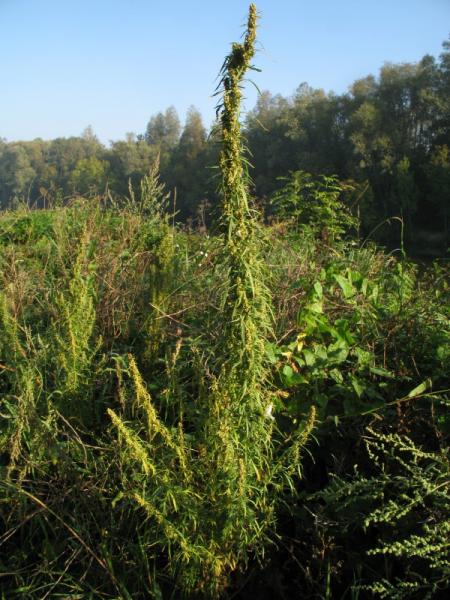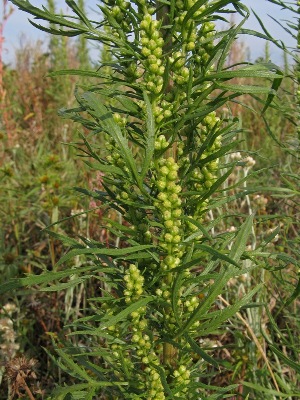Artemisia biennis Willd. (N-Am.) – A rather rare but recently increasing alien. First recorded in a clover field in Korbeek-Loo in 1895 (initially as Artemisia annua). Subsequently found in numerous additional, widely distributed locations. Many records are associated with grain importation (port areas, near granaries,…) (see also Jehlík 1984: Czech records are also mostly related with grain and flax seed from the U.S.A. and Canada). Still frequently introduced nowadays (often in abundance on unloading quays in port areas) and sometimes very persistent for some time on temporarily wet wasteland (for instance in the port of Gent or Antwerpen). Also increasingly recorded in more natural, often very remote habitats, especially marshes (often after a certain disturbance) or sand raised sites. Sometimes occurring in huge numbers (for instance in the surroundings of a railway yard in Saint-Ghislain) but finally decreasing after some years. Records in riparian habitats are rare so far in Belgium. At present Artemisia biennis is probably nowhere fully naturalised but a future naturalisation is very likely. In northwestern France, close to the Belgian frontiers, it is increasingly found as an established agricultural weed in beet fields (see for instance Toussaint & al. 2008). Artemisia biennis obviously is an increasing alien in Europe: it was not yet included in Flora Europaea (Tutin & al. 1976).
The very similar Artemisia tournefortiana, a native of western and central Asia, might have been overlooked. It much resembles Artemisia biennis and is considered to be conspecific according to certain authors. However, it is usually much taller (up to 250 cm), has involucral bracts with a wider membranous margin (and only a narrow green midrib) and an entire (not toothed) leaf rachis. It is naturalised in parts of southwestern Europe but is recently in expansion along motorways in Germany (Brandes 2007, Bank 2008). More or less similar plants were recently recorded on a demolition site of a former beet-processing factory in Veurne.
 |
 |
Selected literature:
Bank C. (2008) Neubürger werden häufiger – ein neuer Pflanzenfund bei Stassfurt – der Armenische Beifuss (Artemisia tournefortiana Reichenb.). Mitt. Bl. FG Faun. u. Ökol. Stassfurt 52: 17-18.
Brandes D. (2007) Artemisia tournefortiana Reichenb. als neue Autobahn-Pflanze. Available online at: www.digibib.tu-bs.de/?docid=00021461
Jehlík V. (1984) Artemisia biennis v Československu. Preslia 56: 319-328.
Palmer J.R. (1984) Artemisia biennis by the Thames. BSBI News 37: 26-27.
Toussaint B., Mercier D., Bedouet F., Hendoux F. & Duhamel F. (2008) Flore de la Flandre française. C.B.N.B.B.L., Bailleul : 556 p.
Tutin T.G., Persson K. & Gutermann W. (1976) Artemisia. In: Tutin T.G. & al. (eds.), Flora Europaea, vol. 4. Cambridge University Press, Cambridge: 178-186.

